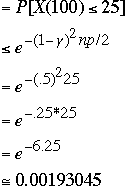 CS 662 Theory of Parallel Algorithms
CS 662 Theory of Parallel Algorithms
Chernoff Bounds
[To Lecture Notes Index]
San Diego State University -- This page last updated March 21, 1996, 1996

Bernoulli Trial
- Experiment with only two possible outcomes: success and failure
p = probability of success
q = probability of failure
q + p = 1
X(n) = number of successes during n independent Bernoulli trials
P[ event ] = the probability of event occurring
We have:
-

-

Chernoff Bounds
1)

2)

Set
 and using 2) we get
and using 2) we get
3)

Example
What is the probability of getting 25 or fewer heads in 100 coin tosses?
p = .5
n = 100
 = .5
= .5

-

| n |  |  |  |
| 100 | 0.9 | 45 | 0.77880078 |
| 100 | 0.8 | 40 | 0.36787944 |
| 100 | 0.7 | 35 | 0.10539922 |
| 100 | 0.6 | 30 | 0.01831564 |
| 100 | 0.5 | 25 | 0.00193045 |
| 100 | 0.4 | 20 | 0.00012341 |
| 100 | 0.3 | 15 | 4.7851E-06 |
| 100 | 0.2 | 10 | 1.1254E-07 |
| 100 | 0.1 | 5 | 1.6052E-09 |
Randomized Algorithms
Las Vegas type algorithm
- Always generates correct answer
-
- Complexity is measured in expected value or the probability that a certain
bound will be exceeded
Monte Carlo type algorithm
- The algorithm will make errors but with a small probability


 CS 662 Theory of Parallel Algorithms
CS 662 Theory of Parallel Algorithms CS 662 Theory of Parallel Algorithms
CS 662 Theory of Parallel Algorithms